We sewed a man’s lips shut on German TV! Lip sewing body modification, Joko & Klaas in Vancouver.

A meditative moment at the beach? Not quite. I’m surrounded by TV crew cameras, and about to force a German man to stitch his mouth together with needle and thread.
I appeared on the popular TV show “Joko und Klaas” or “Circus HalliGalli,” which aired last week on Pro Sieben network. Our body modification episode got a lot of stunned tweets from viewers in Germany. What was so shocking about it?
Lip sewing on German TV! Lips sewn shut, body… by lacarmina
Watch the “Joko in Kanada” video clip, featuring La Carmina, First Mate Naomi, and body mod artist Russ Foxx… if you dare.
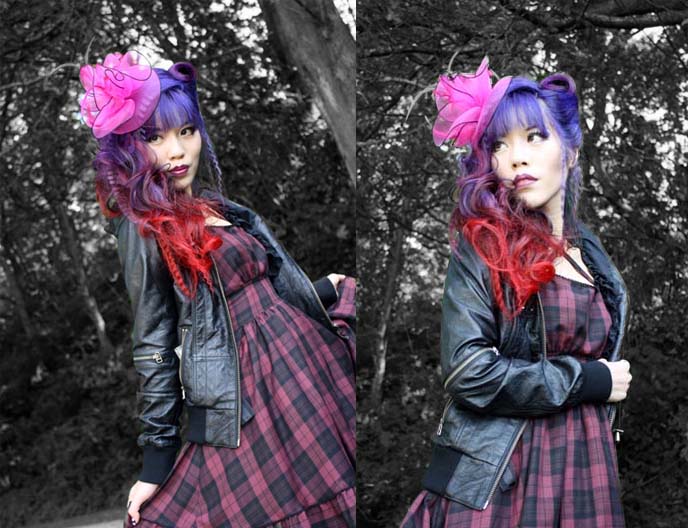
For the shoot, I wore a Miho Matsuda plaid dress from Closet Child, a Danier leather jacket, and Demonia shoes. My hair color and crimped/rolled style is the work of Stephanie Hoy, at Avant Garde hair in Yaletown.

You may recall that we Pirates previously worked with Joko und Klaas, on a bagelhead forehead inflation challenge filmed in Tokyo, Japan. The episode was such a hit that they wanted to do another show with us.
Our TV production company pitched a few crazy ideas, and the one involving lip-sewing in Vancouver stuck. Naomi and I took charge of arranging, casting and coordinating the episode (as well as hosting it).

The night Naomi arrived, tragedy struck. Her hotel was set on fire, and my car window was smashed with a giant rock by a crazy random person. Nobody was hurt, but we were left with quite the shock. On the bright side: the Vancouver Global TV news team decided to interview me about my harrowing experience.

At least my life-long goal of being a hysterical eyewitness on the news has been fulfilled. How funny that I looked like this on camera.
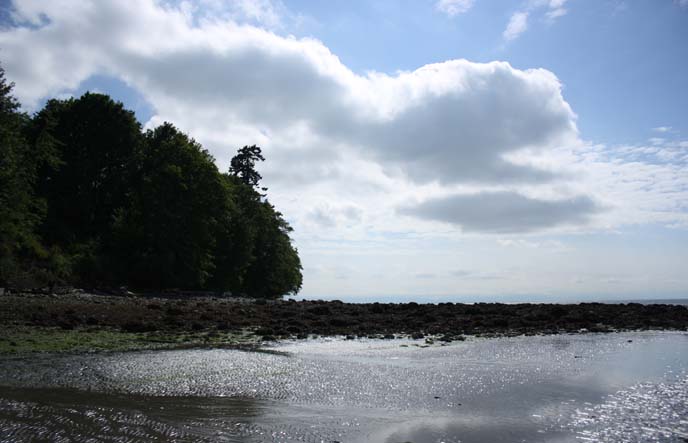
We kicked off the German TV shoot at gorgeous Acadia Beach. (The filming took two days in June, in various Vancouver BC locations.)

The concept of “Duell um die Welt”: Joko and Klaas challenge each other to insane tasks around the world. Relaxing by the ocean, Joko thinks he’s off the hook.

But an Asian horror doll creeps up on him… in the video, you can see how I gave Joko a mighty scare!

Before each take, the director gave us a general idea of the narrative, but we improvised all the lines. The sound boom microphone went back and forth between us as we spoke. We did it a few times, from a few different angles, and then moved on.

With this landscape as our backdrop, it’s easy to make the shots look good.

The 8-person crew (plus Naomi and me) piled into the rental van, and we stopped by Granville Island. I showed Joko the beauty of the marina.

Gotta work the body to get the shot! (Photos in this post by First Mate Naomi.)

We hammed it up — ohohoh! Muahaha! So far, life is a laugh for Joko. He has no idea what’s coming for him…

Getting direction at the Gastown steam clock. You can tell I’m enjoying my TV presenting work.

It was fun to show Joko the tourist-y parts of my hometown. When the clock struck the hour, the steam blew and we danced around in joy.

In front of the Gassy Jack statue, there were inevitably gas jokes.
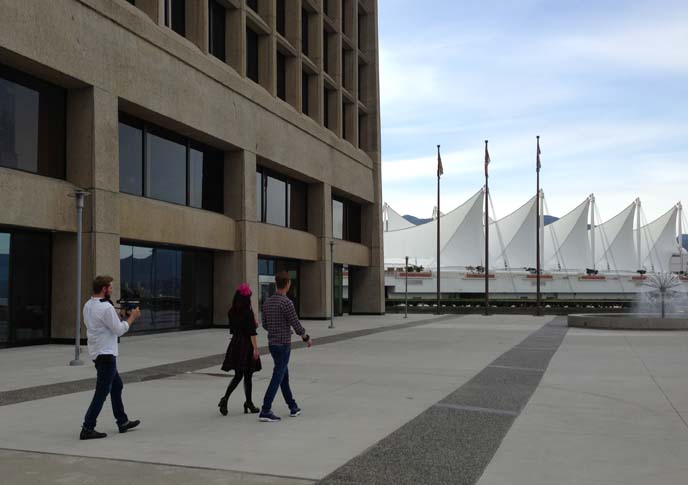
No, that’s not a stalker. It’s how we film walk-and-talk scenes, this time at Pan Pacific.

In all, this ended up being a good travel overview of Vancouver. We finished downtown, at Robson Street. Joko did a somersault in the crosswalk.

Everyone worked quickly and was easygoing — a nice change from the frantic attitude of some TV productions.

However, when night falls, I am not such a nice girl. We reunited with Naomi by the dumpster in a dark alley. She told him, Klaas sent her to deliver a challenge.

Can anything beat a bagelhead? I think we did. We sent Joko to the studio of Russ Foxx… to get lips stitched shut!

If you’ll recall from my HuffPost interview, Russ is a body modification artist based in Vancouver. He made a theatrical entrance that scared the daylights out of Joko.

Lip sewing is an extreme body mod that should only be done by an experienced artist like Russ. Why stitch your lips together? Some do it as a fetish, or to reflect and self-test, or for performance. I’ve seen people with sewn eyelids and mouths firsthand in Prague and Tokyo party scenes.

Russ Foxx made six stitches in total, without anesthetic. He used the utmost precision and sanitation measures, and walked Joko through each step.

The sewing hurts, as much as six lip piercings would. Here’s the finished result. (Wonder why my friend is suddenly speechless…)

For the final scene, we threw an impromptu underground party. None of this would have been possible without Isaac, master of Sin City Fetish night, who pulled together the venue and crowd in record time. Naomi made the poster above for “Spooky Saturday.”

I’m so grateful to everyone who came to The Waldorf to party with us, and be on German TV. Thank you for always supporting me.

DJ Evilyn got people dancing.

I felt bad because the TV shoot ran late, and we couldn’t get to the party until around 1am. Still, there was a grinding crowd and lots of latex outfits!

For the closing scene, we all sang the Crash Test Dummies song, “Mmm mmm mmm mmm.” With his Miffy-mouth, Joko was barely able to hum along.

That’s a wrap! Russ removed Joko’s stitches — you can only keep them in for a few hours — and all was well in the universe again.
Have you heard about the lip sewing body mod before? If you have opinion or questions about it, I invite you to leave a comment and we can discuss.

I hope you enjoyed our latest TV work! Please take a minute to watch it on Dailymotion, and let me know what you think. Thanks to all the German newspapers who wrote about our episode, including Focus, Bild, and News.de

PS: if you’re interested in working with La Carmina & The Pirates, we offer TV coordination, production, casting and hosting services, in Tokyo and worldwide. We’ve worked with National Geographic, Food Network, Travel Channel, Discovery, NHK and more (all clips and details here.)
PPS: Off to Japan soon! We’ve confirmed a new TV job, shooting in Tokyo this December. Stay tuned to my site for casting announcements; we’d love for you to join the fun.
SHARE & COMMENT
A Princess Photoshoot in Sofitel So Bangkok, Christian Lacroix’s fashion luxury hotel.

My mind is swirling with memories of Bangkok. The golden temples, avantgarde street style… I feel inspired and refreshed after my trip to Thailand, and am eager to share my stories with you!
We’ll start with a photoshoot inside Sofitel So, a modern hotel styled by famed designer Christian Lacroix.
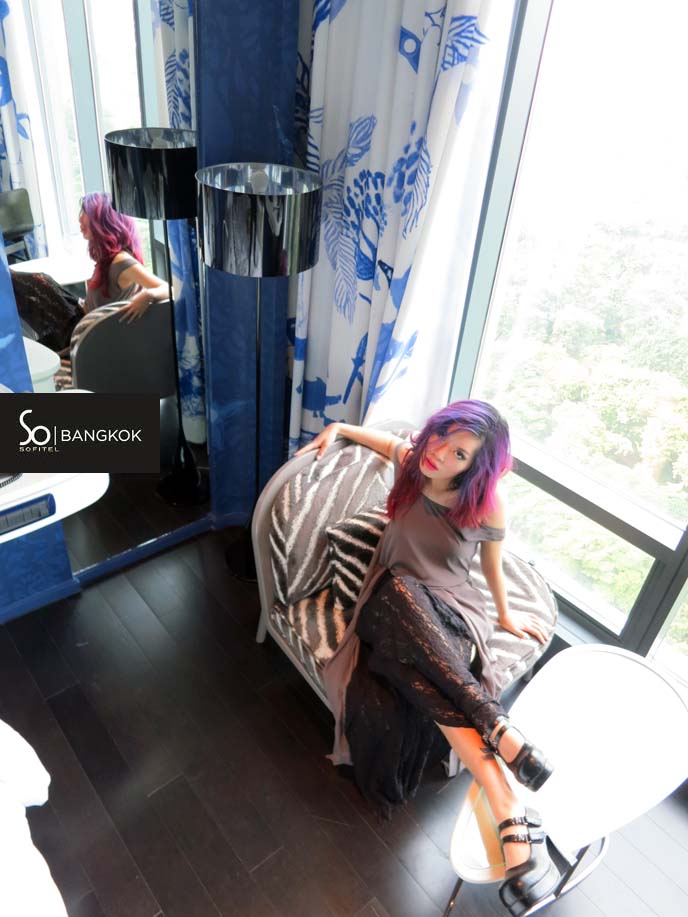
As you’ll recall, Thai Tourism sent Seby and me to report on the city’s innovative fashion, pop culture and districts.
No hostels and backpacking for this duo. We were hosted by Sofitel So Bangkok, a blissfully elegant 5-star hotel in a central location (about 10 min south of my favorite local mall, Siam Discovery, which I’ll show you soon).
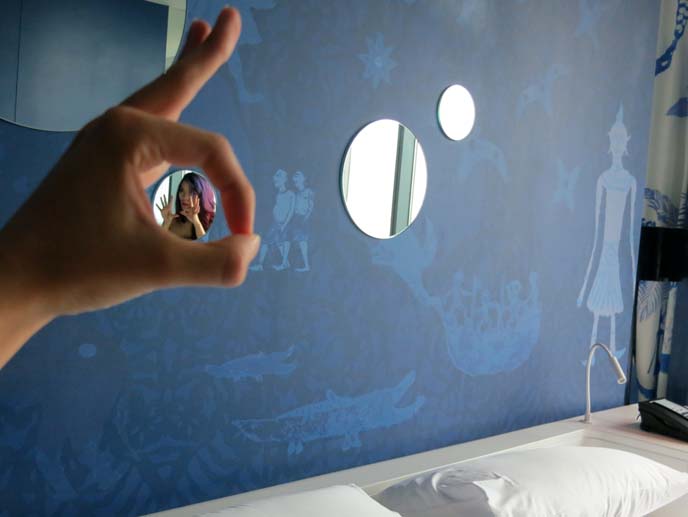
Before you assume our stay is out of your budget — remember, this is Southeast Asia. Luxury hotels and spas are literally a third of the price you’d pay in Vancouver, LA, London or Tokyo. It’s great value to spend a bit more for a nice room in Bangkok, especially if you’re here for a honeymoon or special trip.

The hotel is divided into five Elements, with each theme customized by different designer. My cavern-like blue abode is part of the Earth group. Other guests stay in Water, Wood, Metal and Fire rooms (interior photos coming soon).
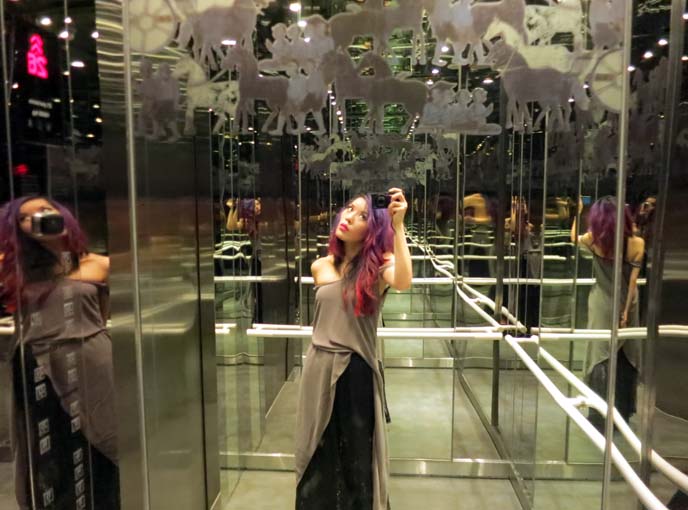
Since I’m a design-addict, I appreciated the subtle decorative elements everywhere, such as these horse and human silhouettes reflected in the elevator mirrors.

Who is this chic lady next to me? One of the sweet staff members! French couture genius Christian Lacroix designed all the hotel uniforms — what a nice perk of working here. I’m doing my best to match her style in a grey, drapey 2Percent top/dress from Hong Kong.

Monsieur Lacroix also had his hand in the lobby’s design, as you can tell from the imaginative lighting and furniture.

Seby and I had “Club Signature” access, which meant a number of benefits including entry to the 25th floor lounge. (Most of these photos are by Seby.)
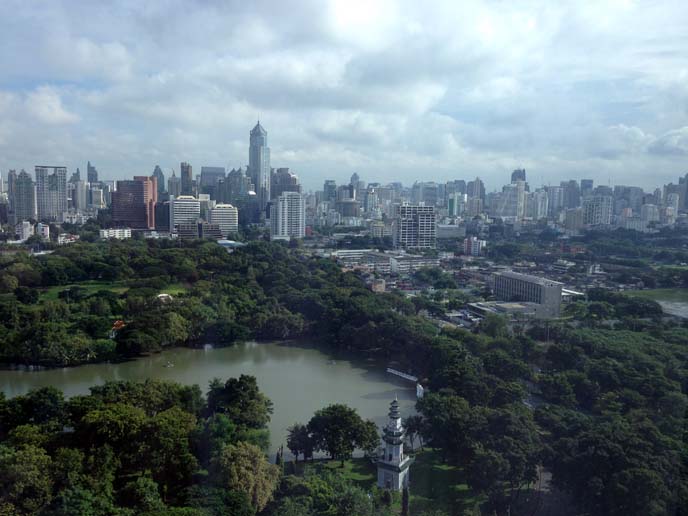
The Club Lounge balcony gave us this view of Lumpini Park. We traveled to Bangkok in early October, during the rainy season, but the weather was pleasant — it only rained briefly — and I didn’t get a single bite from my nemesis, the mosquito.

We spent a lot of time in this VIP lounge, also designed by Christian Lacroix. After a day of sightseeing, it was nice to unwind with free cocktails, look at the fashion displays and magazines, and snack on the never-ending supply of food.

Even the fresh pineapple had a pretty shape!
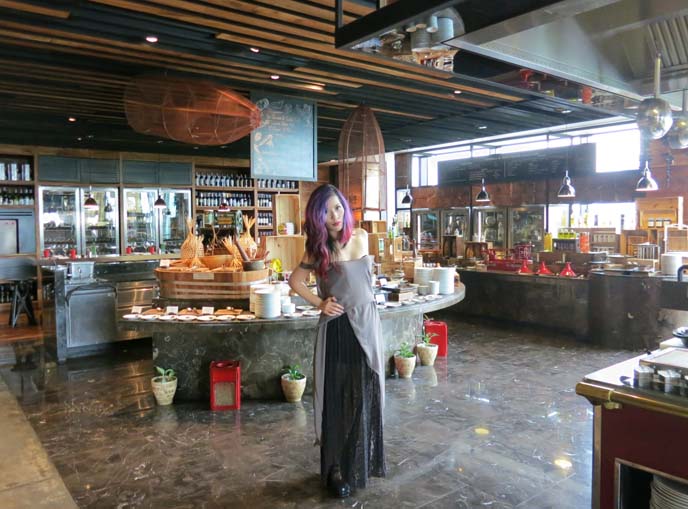
In the mornings, we couldn’t wait to come downstairs for breakfast. The selection included…

… Greek yogurt, tropical fruits, smoked salmon, cottage cheese, special salads, and fresh mango juice.

And if, by some miracle, you are still hungry — there is a Bonnet chocolate shop on the ground floor.

Since it was near Halloween, the main window featured Jack O Lanterns and bloody eyeballs. For those with less morbid inclinations, there were gourmet cakes, chocolates and other sweets.
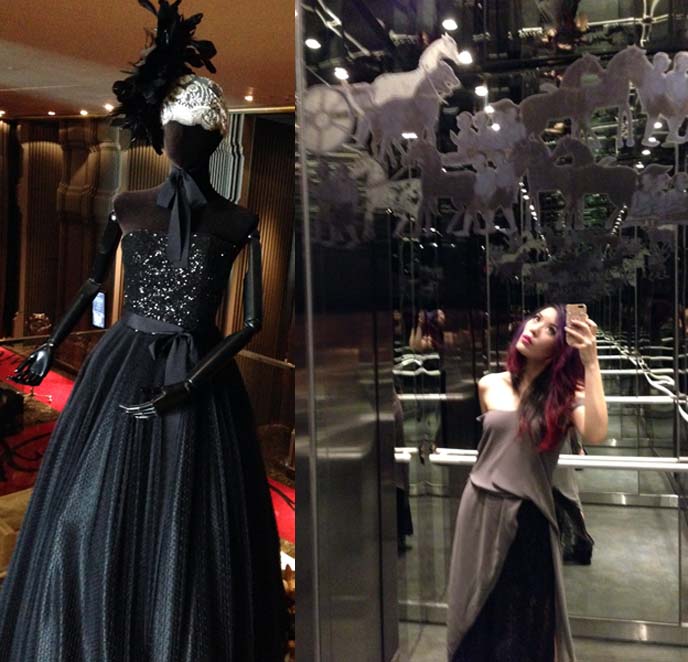
The couture theme extends throughout the hotel. Near the elevators stood a ballgown by Thai designer, Tawn C.

The dress was surrounded by these gold bunnies.

Not far away, this goat greeted guests.
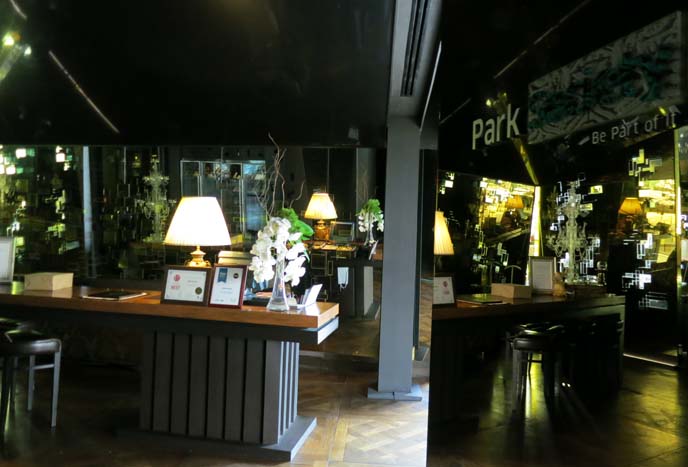
On the first evening, Seby and I had dinner at Park Society, the top floor restaurant with a futuristic feel.
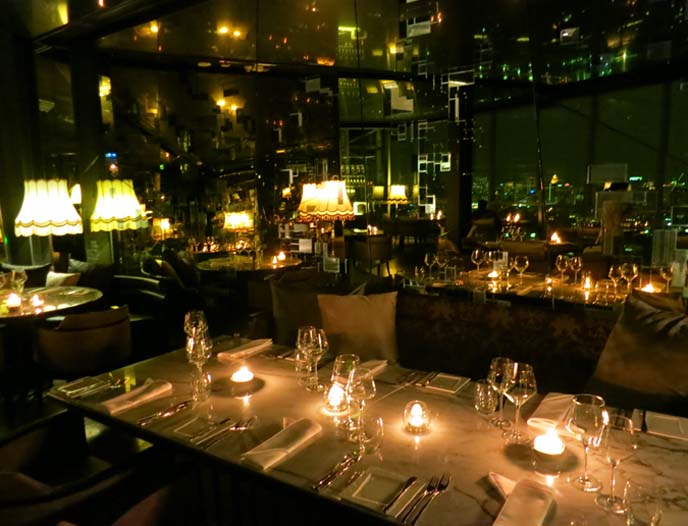
A woman in a long flowing gown led us to our table, through a matrix of glass, mirrors and stainless steel.
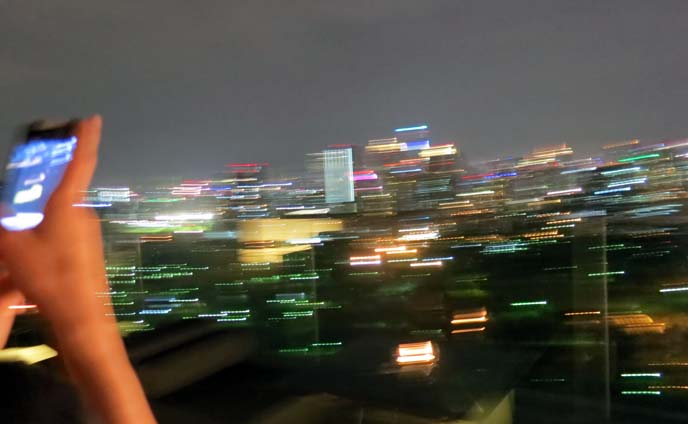
Our table overlooked the bright lights of Bangkok. Outside, customers lounged and drank molecular cocktails at Hiso rooftop bar.
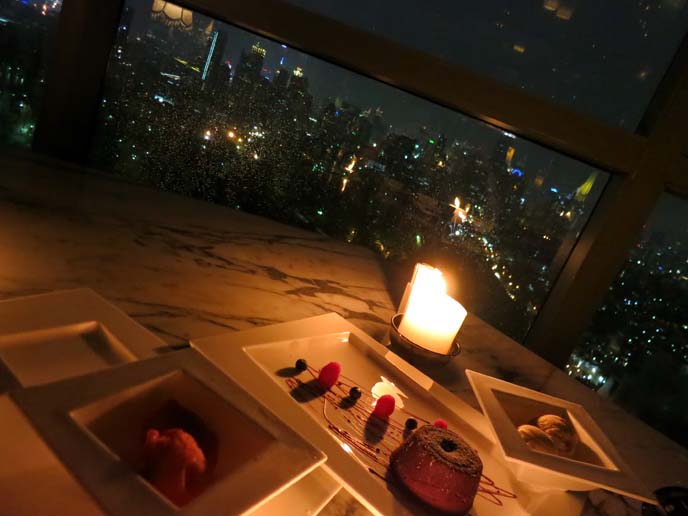
It happened to be the Thailand Vegetarian Festival, a time for locals to cleanse their bodies for health and peace. To celebrate, Park Society offered a meatless tasting menu. I was in heaven since they served two of my favorite dishes: pumpkin ravioli and warm, chocolate lava cake.
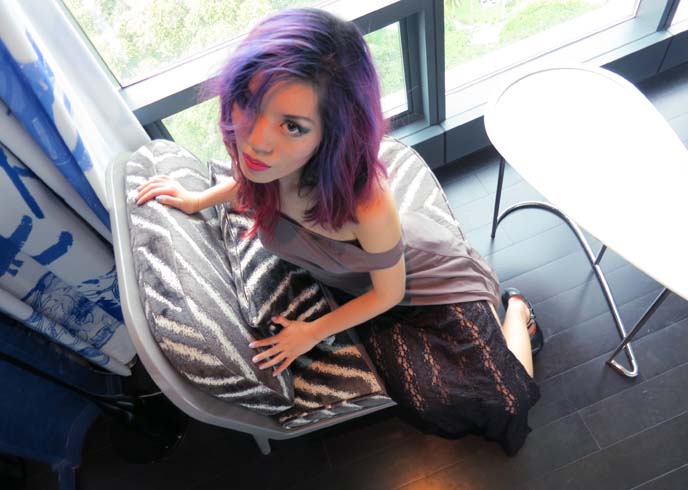
Can you tell I had a wonderful time at the Sofitel So Hotel? So, so worth the splurge if you travel to Bangkok! I still have to take you inside their spa, swimming pool and unique rooms.
And of course, Seby and I did plenty of urban exploration. Coming up: reports on the coolest Thai clubs and fashion.
Are you an admirer of Christian Lacroix’s work? What do you think of our royal Thailand experience so far?
 LA CARMINA
LA CARMINA






